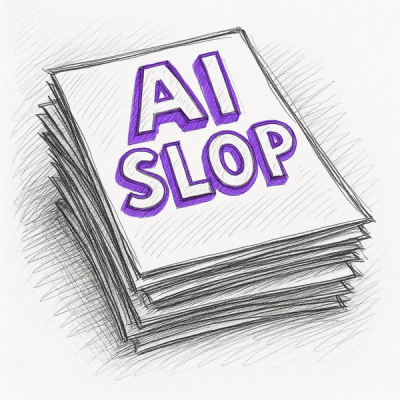
Security News
Django Joins curl in Pushing Back on AI Slop Security Reports
Django has updated its security policies to reject AI-generated vulnerability reports that include fabricated or unverifiable content.
| |travisci| |version| |versions| |impls| |wheel| |coverage|
.. |travisci| image:: https://travis-ci.org/jonathaneunice/textdata.svg?branch=master :alt: Travis CI build status :target: https://travis-ci.org/jonathaneunice/textdata
.. |version| image:: http://img.shields.io/pypi/v/textdata.svg?style=flat :alt: PyPI Package latest release :target: https://pypi.org/project/textdata
.. |versions| image:: https://img.shields.io/pypi/pyversions/textdata.svg :alt: Supported versions :target: https://pypi.org/project/textdata
.. |impls| image:: https://img.shields.io/pypi/implementation/textdata.svg :alt: Supported implementations :target: https://pypi.org/project/textdata
.. |wheel| image:: https://img.shields.io/pypi/wheel/textdata.svg :alt: Wheel packaging support :target: https://pypi.org/project/textdata
.. |coverage| image:: https://img.shields.io/badge/test_coverage-99%25-blue.svg :alt: Test line coverage :target: https://pypi.org/project/textdata
One often needs to state data in program source. Python, however, needs its
program lines indented just so. Multi-line strings therefore often have extra
spaces and newline characters you didn't really want. Many developers "fix"
this by using Python list literals, but that's tedious, verbose, and often
less legible.
The textdata package makes it easy to have clean, nicely-whitespaced
data specified in your program, but to get the data without extra syntax
cluttering things up. It's permissive of the layouts needed to make Python
code look and work right, without reflecting those requirements in the
resulting data.
.. code-block:: pycon
>>> lines("""
... There was an old woman who lived in a shoe.
... She had so many children, she didn't know what to do;
... She gave them some broth without any bread;
... Then whipped them all soundly and put them to bed.
... """)
['There was an old woman who lived in a shoe.',
"She had so many children, she didn't know what to do;",
'She gave them some broth without any bread;',
'Then whipped them all soundly and put them to bed.']
Note that the "extra" newlines and leading spaces have been taken care of and discarded. Or do you want that as just one string? Okay:
.. code-block:: pycon
>>> text("""
... There was an old woman who lived in a shoe.
... She had so many children, she didn't know what to do;
... She gave them some broth without any bread;
... Then whipped them all soundly and put them to bed.
... """)
"There was an old woman who lived in a shoe.\nShe ...put them to bed."
Here text() does the same stripping of pointless whitespace at the beginning
and end of lines, returning the data as a clean, convenient string. Or if you
don't want most of the line endings, try textline on the same input to get a
single no-breaks line.
Other times, the data you need is almost, but not quite, a series of
words. A list of names, a list of colors--values that are mostly
single words, but sometimes have an embedded spaces. textdata has you
covered:
.. code-block:: pycon
>>> words(' Billy Bobby "Mr. Smith" "Mrs. Jones" ')
['Billy', 'Bobby', 'Mr. Smith', 'Mrs. Jones']
Embedded quotes (either single or double) can be used to construct "words" (or phrases) containing whitespace (including tabs and newlines).
words, like the other textdata facilities, allows you to
comment individual lines that would otherwise muck up string literals:
.. code-block:: pycon
exclude = words("""
__pycache__ *.pyc *.pyo # compilation artifacts
.hg* .git* # repository artifacts
.coverage # code tool artifacts
.DS_Store # platform artifacts
""")
Yields:
.. code-block:: pycon
['__pycache__', '*.pyc', '*.pyo', '.hg*', '.git*',
'.coverage', '.DS_Store']
Instead of words, you might wan to collect "paragraphs"--contiguous runs of text lines delineated by blank lines. Markdown and RST document formats, for example, use this convention.
.. code-block:: pycon
>>> rhyme = """
Hey diddle diddle,
The cat and the fiddle,
The cow jumped over the moon.
The little dog laughed,
To see such sport,
And the dish ran away with the spoon.
"""
>>> paras(rhyme)
[['Hey diddle diddle,'],
['The cat and the fiddle,',
'The cow jumped over the moon.',
'The little dog laughed,',
'To see such sport,'],
['And the dish ran away with the spoon.']]
Or if you'd like paras, but each paragraph in a single string:
.. code-block:: pycon
>>> paras(rhyme, join="\n")
['Hey diddle diddle,',
'The cat and the fiddle,\nThe cow jumped over the moon.\nThe little dog laughed,\nTo see such sport,',
'And the dish ran away with the spoon.']
Or maybe you want a dict. The attrs function makes it easy to
grab::
.. code-block:: pycon
>>> attrs("a=1 b=2 c='something more'")
{'a': 1, 'b': 2, 'c': 'something more'}
If you want to cut and paste data directly from JavaScript, JSON, HTML, CSS, or XML, easy peasy! No text editing required.
.. code-block:: pycon
>>> # JavaScript
>>> attrs("a: 1, b: 2, c: 'something more'")
{'a': 1, 'b': 2, 'c': 'something more'}
>>> # JSON
>>> attrs('"a": 1, "b": 2, "c": "something more"')
{'a': 1, 'b': 2, 'c': 'something more'}
>>> # HTML or XML
>>> attrs('a="1" b="2" c="something more"')
{'a': '1', 'b': '2', 'c': 'something more'}
>>> # above returns strings, because values quoted, which denotes strings
>>> # 'full' evaluation needed to transform strings into values
>>> attrs('a="1" b="2" c="something more"', evaluate='full')
{'a': 1, 'b': 2, 'c': 'something more'}
>>> # CSS
>>> attrs("a: 1; b: 2; c: 'something more'")
{'a': 1, 'b': 2, 'c': 'something more'}
Or maybe you have tabular data.
.. code-block:: pycon
>>> tabledata = """
... name age strengths
... ---- --- ---------------
... Joe 12 woodworking
... Jill 12 slingshot
... Meg 13 snark, snapchat
... """
>>> table(tabledata)
[['name', 'age', 'strengths'],
['Joe', 12, 'woodworking'],
['Jill', 12, 'slingshot'],
['Meg', 13, 'snark, snapchat']]
>>> records(tabledata)
[{'name': 'Joe', 'age': 12, 'strengths': 'woodworking'},
{'name': 'Jill', 'age': 12, 'strengths': 'slingshot'},
{'name': 'Meg', 'age': 13, 'strengths': 'snark, snapchat'}]
This works even if you have a table with a lot of extra fluff:
.. code-block:: pycon
>>> fancy = """
... +------+-----+-----------------+
... | name | age | strengths |
... +------+-----+-----------------+
... | Joe | 12 | woodworking |
... | Jill | 12 | slingshot |
... | Meg | 13 | snark, snapchat |
... +------+-----+-----------------+
... """
>>> assert table(tabledata) == table(fancy)
>>> assert records(tabledata) == records(fancy)
It works with tables formatted in a variety of ways including Markdown, RST,
ANSI/Unicode line drawing characters, plain text columns and borders.... You'd
might think table parsing would be a dicey proposition, prone to failure, but
textdata has dozens of tests, including rather complex cases, showing
it's a reliable, high-probability heuristic.
textdata is all about conveniently grabbing the data you want from text
files and program source, and doing it in a highly functional, convenient,
well-tested way. Take it for a spin today!
See the full documentation at Read the Docs <https://textdata.readthedocs.org/en/latest/>_.
FAQs
Easily get clean data, direct from text or Python source
We found that textdata demonstrated a healthy version release cadence and project activity because the last version was released less than a year ago. It has 1 open source maintainer collaborating on the project.
Did you know?

Socket for GitHub automatically highlights issues in each pull request and monitors the health of all your open source dependencies. Discover the contents of your packages and block harmful activity before you install or update your dependencies.

Security News
Django has updated its security policies to reject AI-generated vulnerability reports that include fabricated or unverifiable content.

Security News
ECMAScript 2025 introduces Iterator Helpers, Set methods, JSON modules, and more in its latest spec update approved by Ecma in June 2025.

Security News
A new Node.js homepage button linking to paid support for EOL versions has sparked a heated discussion among contributors and the wider community.